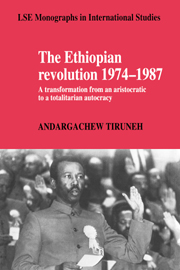 The Ethiopian Revolution 1974–1987
The Ethiopian Revolution 1974–1987 Book contents
- Frontmatter
- Contents
- List of maps and tables
- Acknowledgements
- List of abbreviations
- Map 1 The Horn of Africa
- Map 2 Administrative divisions
- 1 The background to the emergence of the structural crisis
- PART I THE COLLAPSE OF THE OLD-STATE (JANUARY–NOVEMBER 1974)
- PART II THE FORMATIVE YEARS OF THE POST-REVOLUTIONARY ORDER (DECEMBER 1974–FEBRUARY 1977)
- PART III CONSOLIDATION OF POWER (FEBRUARY 1977–SEPTEMBER 1987)
- 8 The elimination of internal and external threats to Mengistu's power
- 9 The formation of the Workers' Party of Ethiopia
- 10 The formalization of power through the 1987 constitution: ‘organizational operation’ in action
- 11 Conclusion
- Postscript
- Appendix: chronology of events
- Notes
- Bibliography
- Index
- LSE MONOGRAPHS IN INTERNATIONAL STUDIES
8 - The elimination of internal and external threats to Mengistu's power
Published online by Cambridge University Press: 18 December 2009
- Frontmatter
- Contents
- List of maps and tables
- Acknowledgements
- List of abbreviations
- Map 1 The Horn of Africa
- Map 2 Administrative divisions
- 1 The background to the emergence of the structural crisis
- PART I THE COLLAPSE OF THE OLD-STATE (JANUARY–NOVEMBER 1974)
- PART II THE FORMATIVE YEARS OF THE POST-REVOLUTIONARY ORDER (DECEMBER 1974–FEBRUARY 1977)
- PART III CONSOLIDATION OF POWER (FEBRUARY 1977–SEPTEMBER 1987)
- 8 The elimination of internal and external threats to Mengistu's power
- 9 The formation of the Workers' Party of Ethiopia
- 10 The formalization of power through the 1987 constitution: ‘organizational operation’ in action
- 11 Conclusion
- Postscript
- Appendix: chronology of events
- Notes
- Bibliography
- Index
- LSE MONOGRAPHS IN INTERNATIONAL STUDIES
Summary
‘REVOLUTIONARY ETHIOPIA OR DEATH’
Like most dictators, Mengistu was not only head of the government but also head of state and as such personified the state. As of 1977, therefore, it became increasingly difficult to distinguish between the threats directed against him and those directed against the state. By and large it can perhaps be stated that whereas the internal opposition was a threat against Mengistu's position as a leader, the external invasion can be taken as a threat both to him as a leader and to the state.
When Mengistu assumed absolutist powers in February 1977, the government was engulfed by internal and external threats with the result that Ethiopia looked as though it was on the point of dismemberment. In the urban centres, Mengistu's coalition was locked into an assassination and counter-assassination match with the EPRP. In the north-west, EDU had captured the border towns of Metema and Setit-Humera, and was poised to capture the provincial capital of Gondar. In the north, the Eritrean Liberation Front, the Eritrean People's Liberation Front, EDU and the Tigrai People's Liberation Front had brought chunks of the Eritrean and Tigrain countryside under their control and had besieged the major towns in those provinces. In the east, the Afar Liberation Front had been destroying military convoys and garrisons and periodically cutting the road leading to the only port of Assab which was still under government control.
- Type
- Chapter
- Information
- The Ethiopian Revolution 1974–1987A Transformation from an Aristocratic to a Totalitarian Autocracy, pp. 205 - 226Publisher: Cambridge University PressPrint publication year: 1993


